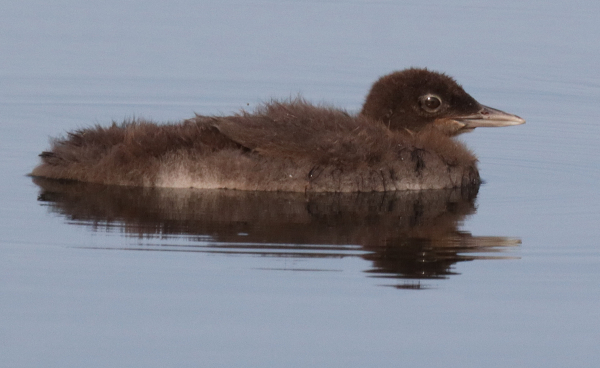
A downy Common Loon hatchling was photographed during a surprise second encounter with a loon family that provided some especially memorable observations and photos.

A tranquil view of the hatchling loon floating near the adult on glassy water on a beautiful summer’s morn. You can see more photos of the loons in the Bird Photography feature in this issue.
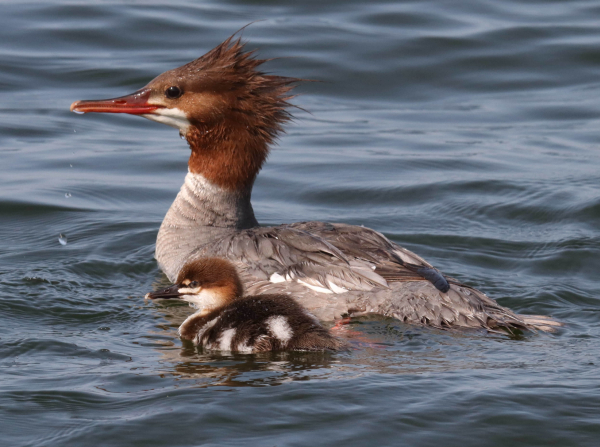
An initial look at a female Common Merganser and her days old duckling was eclipsed by the surfacing of 20 more downy ducklings!
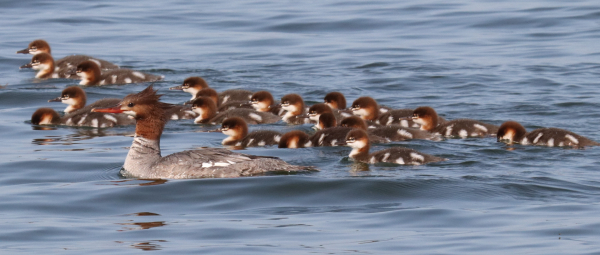
Probably the product of a second female laying a clutch of eggs in this female merganser’s cavity nest, the mega-brood of 21 ducklings surrounded the hen before resuming their diving searches for food, popping back into view a minute or so later in rapid succession.
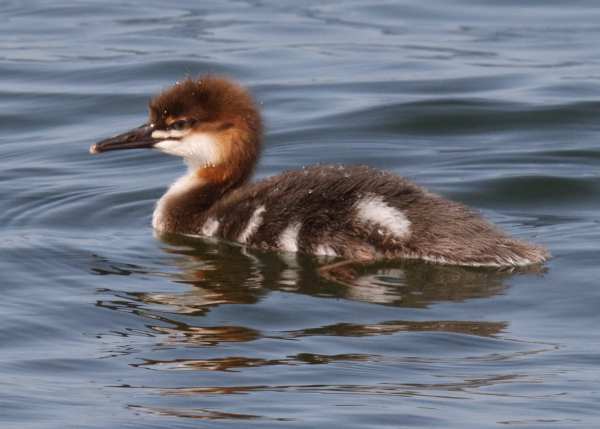
A close view of a downy Common Merganser duckling shows its stunning color pattern and its specially adapted long thin bill, used to catch small fish and large aquatic bugs while diving under water.
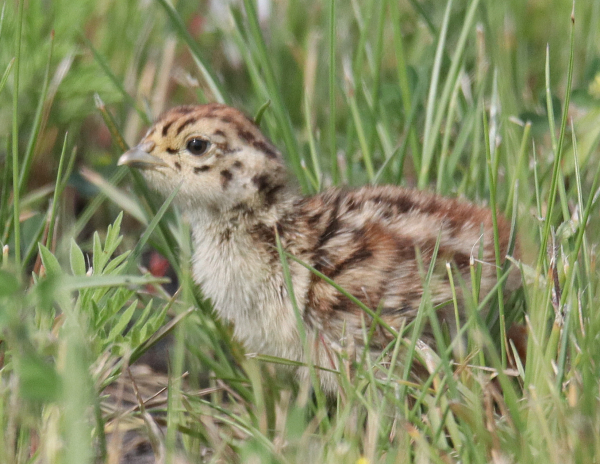
Although the quick movement of a newly hatched brood of Gray Partridges made any hope of a clear photo questionable, this image made the grade to share a close view of a hatchling rarely seen or photographed at this early age.
|
The parade of new fledglings and hatchlings continues; this week’s list new fledglings included Bald Eagles, Ferruginous Hawks, Franklin’s Gulls, and more Eastern Kingbirds, American Kestrels, and Mourning Doves. New hatchlings were a brood of tiny Gray Partridges, American Avocets, Killdeer, new broods of Wood Ducks, Northern Shovelers, Lesser Scaup, and a couple broods of Northern Pintails along with more broods of the 4 most common duck species – Blue-winged Teal, Mallards, Gadwalls, and Redheads.
My plans for days off last week were cast to the wind when I heard from my great friend and cousin Dwight, who was flying in from Portland, Oregon the next day. Dwight’s first stop was going to be Andy’s lake home near Detroit Lakes, Minnesota, so after checking with Andy and visiting my 4 nephews and 2 nieces in Fargo, the loons were calling me to Minnesota. Dwight really wanted to do another loon cruise (annual for him), so with the calm evening creating a glass-like lake surface, mirroring the multi-green colors of the woodland trees before sunset, with loons calling periodically emphasized the potential for manana.
The following morning the lake retained its calm glassy surface, and with blue sky and perfect sunlight, we were in business. From Andy’s deck I could see a loon on the south side of the lake where we photographed a pair of Common Loons with a downy hatchling 10 days earlier, so with Andy at the helm of his “luxury loon pontoon,” we headed in that direction. As we approached the motionless adult as it floated on the edge of the shallows, I saw the downy loon floating among a few widely spaced small emergent reeds. Clearly unconcerned by our arrival, the loons appeared to be resting and the female provided some classic photos on the ripple-less water (they turned out to be some of my favorite photos).
We were about to leave when the downy loon swam into the open to join the adult, stretching its down-covered wings over its back, then following the adult on a slow gradual move into more open water. Andy paralleled the loons from a distance as I photographed, and at that point we were all satiated with the tranquil thrill of this loon encounter. We broke away to leave the loons to their lake-bound day, but the loon cruise wasn’t over. Andy wanted to give Dwight a look at the larger adjoining lake, connected by a broad stream lined by cattails, to search for other loons and wildlife along the northeast and southeast shorelines. (You can learn more about our loon photo session in the Bird Photography feature in this issue.)
On the big lake, in addition to seeing more adult loons along with a couple Bald Eagles and Ospreys, as we were exiting the bigger lake Andy spied a female Common Merganser with a newly hatched duckling that apparently just surfaced off the bow of the boat as we were checking out a North Woods lodge. Suddenly we were marveled by an assemblage of ducklings that literally popped into view from below water in quick succession one at a time, but 20 more ducklings to be exact. It was a funny and memorable birding moment. Andy eased the boat to a better lighting vantage point as the ducklings rallied around the female for some moments before resuming their dives under water and re-popping into view – pop-pop-pop-pop-pop! Tooo Koool.
On my way back from the lakes, I observed an adult Bald Eagle with a dark-brown fledgling, initially perched in a dead tree, but they dropped down to the ground before I reached them. As I approached the spot the eagles took flight, giving me a chance to see how well the young eagle could fly. While its flight was a bit labored, it flew well already, but found another perch fairly quickly, flying little more than 100 yards. The fledgling chose a perch hidden by leaves, but the adult provided a chance to photograph it perched on the barkless bleached-white snag.
Other Minnesota birds included a pair of Trumpeter Swans, and a group of 8 miles apart. The larger group of Trumpeters was probably a non-breeding flock of younger swans. There were also a few Belted Kingfishers along the way; and before leaving Andy’s lake property I also enjoyed seeing a couple favorite songbirds – a singing male American Redstart and a male Baltimore Oriole. On the Dakota side of my return drive home I stopped to check on the brood of fledgling American Kestrels in southwest Fargo – the kestrels I photographed the previous 2 weeks – but there was no sign of them during an extended observation period. They apparently moved on, perhaps continuing as a family group for another week or so.
However, there was a pair of Gray Partridges present, as there has been during each of my visits to this location. After all, I found the fledgling kestrels while checking for Gray Partridges that I’ve been monitoring during the past 9 months. But Wait! The female apparently had a couple new hatchlings following her! No, there were many more than 2, there were actually 8 tiny downy new hatchlings following the female, mostly hidden among the short grass where they were already foraging on their own.
I was surprised at how close I was permitted to approach the female and brood with my car, easing slowly into position – and of course, when I thought I was almost too close, the partridges foraged in my direction, with fuzzy hatchlings edging into an opening in the low grass, teasing me to photograph them before slipping back behind grassy cover. Only after seeing the photos later that evening did I know I managed a couple nice images of a tiny hatchling or two – woo-woo.
Closer to Home
In the surrounding area, the most obvious birds have been Upland Sandpipers, Killdeer, Orchard Orioles, Eastern Kingbirds, Black-crowned Night Herons, with a few Swainson’s Hawks and 2 solo American Kestrels. Recent arrivals include a flock of Stilt Sandpipers feeding at an area rainwater pond, fresh from Arctic nesting areas, with Lesser Yellowlegs and Killdeer mixed among them. A tight flock of 27 American Avocets was feeding on a large rainwater marsh, moving in concert to harvest what must have been an especially abundant hatch of aquatic invertebrates. Two separate sightings of Red-headed Woodpeckers were also highlights.
During a Sunday birding drive with Dwight, who arrived for a hometown visit after his Minnesota lakes stay, we saw the first returning flock of Franklin’s Gulls were evident on an area lake with recent fledglings among them. While the first sightings of a Lesser Scaup brood (8 ducklings) and a Northern Shoveler with 4 ducklings were noteworthy, it was also interesting to see a mixed flock of Canvasbacks and Ring-necked Ducks, 2 species I haven’t seen lately. Other birds included Common Nighthawks, more Upland Sandpipers, a Wilson’s Snipe, Eastern Kingbirds, a male Northern Harrier, and a distinctive Krider’s Red-tailed Hawk that showed a mostly white tail, underside, and head.
During our second birding drive Monday, we drove west then north to check on the Ferruginous Hawk nests I’ve been keeping an eye on, and to see what else we could find along the way as we crossed the broad prairie landscape. There were plenty of Swainson’s Hawks scattered among the landscape, including one impressive yearling that I photographed; there were also a few Red-tails that included one particularly scraggly looking yearling in heavy molt, and one female Northern Harrier on the fly. I was able to show Dwight a few Chestnut-collared Longspurs including males performing flight displays, and there were many duck broods, most notably 4 broods in 1 marsh that included a Northern Shoveler brood, 2 Mallard broods, and a Blue-winged Teal brood.
An exciting find closer to home was a flock of more than 100 Long-billed Dowitchers, still in their rufous breeding plumage and newly arrived from Arctic nesting territories. They were concentrated in 3 areas of a large rainwater pond, so large that I couldn’t accurately identify the many small sandpipers scattered along the far shoreline. The wind seemed to be dictating where the shorebirds were actively feeding, and the wind undoubtedly curtailed a lot of avian activity, but it was a great ride, and we had some interesting Ferruginous Hawk action too.
Monitoring Ferruginous Fledglings
Throughout the nesting season, I’ve been monitoring 2 pairs of nesting Ferruginous Hawks at their large annually used nests. While I’ve kept you aware of the nestlings’ rapid growth, it’s the pre-fledging and post-fledging periods that interest me most about these muy especial raptors. When I checked the nests on July 6 the northern nest had 4 nestlings on hand, 1 in the nest, and 3 others perched a few feet from the nest on branches that supported the nest. On July 8, the 4 north Ferrugs were all essentially in the nest, although 2 were perched on branches within 2 feet of nest – spreading out in essence.
Monday, with Dwight along, we didn’t see any fledglings near the north nest, but both adults were present, the male soaring high, and the female perched on a fence post next to the road. With the sun behind the big hawk, I tried driving past her to position between the hawk and the sun, and she didn’t seem to mind me passing. I took a few photos of her as she looked this way and that from her perch, and while she made a long ruffling motion of her entire body plumage. I expected her to fly after the ruffle and indeed she did take flight, moving to perch in a tree near the nest. That was my first close introduction to the adults after years of visiting this nest site, with previous sightings limited an adult perched at the nest, rarely.
At the south nest, Dwight and I saw 2 fledglings perched atop the nest, which seemed kinda redundant considering all 3 fledged more than a week ago. On July 6th, the southern nest already had 3 branchers perched in the next tree to the south of the nest, with the adult female perched on top of a broken branch in a tree about 80 feet north of the nest. During my July 8th visit, 2 of the young Ferruginous Hawks were feeding in the nest with the adult female perched on the rim. The third fledgling was perched in the tree 80 feet north, stretching its wings and preening. When I returned about 40 minutes later, the adult pair was soaring together above and a bit east of the nest, with the young Ferrugs in the same positions as before.
Last Saturday (July 12), there were 2 fledglings from the south nest perched side by side, facing in opposite directions in the tree 80 feet north of the nest, which provided an interesting long-distance photo, while the third fledgling was perched on an adjacent branch. I couldn’t help but want to try for a closer photo, and if the fledglings took flight, I really wanted to see how good they could fly. I opened my car door, took just a few steps, and that’s all it took for the 2 fledglings to take flight, 1 after the other – a testament for staying in my mobile blind rather than exposing my humanity to wildlife. The fledglings could fly quite well, even circling low over the open grassland to the east. I left the area quickly with the hope they would return to their preferred perches near the nest.
Closest to Home
My feeding station is definitely in the midst of the summer doldrums now, and the last of my spring orioles, an adult female Orchard Oriole, moved on as of Saturday. I have had a few quick surprise window visits that included a molting female Hairy Woodpecker and a female American Goldfinch, and the 2 fledgling Mourning Doves continue to frequent open ground spaces of my yard. Beyond that, the regulars are limited to at least 1 Gray Catbird, a pair of American Robins, House Finches, and the Western Kingbirds.
At the nearby rainwater pond, the downy Willet hatchlings left last Wednesday, although I crossed paths with 1 hatchling and an adult Saturday about halfway to Melodie’s Marsh, a quarter mile south of my office. When I searched another rainwater pond closer to the Marsh with binoculars, I could see 2 downy American Avocet hatchlings under the watch of an adult.
The 2 short-term rainwater ponds have provided short-term habitat for a pair of nesting avocets and their hatchlings, the pair of nesting Willets and their 2 hatchlings, as well as many Killdeer and a number of ducks, including Gadwalls, Blue-winged Teal, and Mallards. Plus, by Friday the Willets’ drying rainwater pond attracted 5 Least Sandpipers and 3 White-rumped Sandpipers, possibly directly after they migrated from their Arctic nesting range. It emphasizes the importance of these shallow waters, that incidentally are rapidly drying as the area has missed the last 2 rain fronts that moved through neighboring areas – and that’s why they call these short-lived seasonal wetlands “ephemeral.”
It's also a testament to the fact that things change quickly across the Northern Plains, almost weekly in the case of birds that face a short nesting and post-fledging window of operations. Don’t delay too long between your birding activities during this very active period, when new fledglings and hatchlings are appearing each week, if not daily, and when the first Arctic-nesting sandpipers are filtering south and other birds disperse from nesting ranges in other regions. Birds are on the move again, and it’s a good time to see birds you haven’t encountered to date this year. In short, get out there to enjoy the great outdoors and the birds you see along the way!
Article and Photos by Paul Konrad
Share your bird sightings and photographs at editorstbw2@gmail.com